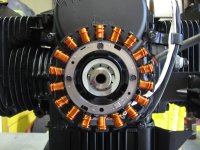Hello Jim
I do not take credit for this.
It's from a member on another forum.
With the tractor off and not running and the key in the off position, unplug the outer two leads from the voltage regulator. These are the stator leads. Use a digital meter, and check each lead for continuity to ground. There should be no continuity. If there is, it indicates a short in the stator or the stator leads, in which case, you'd need to replace the stator.
Next, you need to check the resistance (ohms) between the two leads. For a P218G "A", the resistance should be 0.06 to 0.10 ohms; for a P218G "B" or "C" - 0.10 to 0.19 ohms.
So if that checks, you need to fire up the old 316 - stator leads are still disconnected. With a digital volt meter, check the AC voltage coming off the leads. A minimum of 28 VAC is needed. Upper 30s to low 40s is more common. If you get less than 29 VAC, the stator is most likely weak. In fact, low 30s, while not the end of the line for the stator, would certainly make me consider changing it. For a P218G "A", the AC voltage should be 28 to 41; for a P218G "B" or "C" - 28 to 57.
Now, if the stator checks o.k., you next need to check the voltage regulator. Whatever you do, always make sure the voltage regulator is securely mounted and the attaching sheet metal is as well. A poorly grounded voltage regulator will lead to burnout. With the tractor off, not running and the key in the off position, reconnect the outer two leads to the regulator. Then, disconnect the middle lead.
You are going to check this middle lead for Volts DC. Using a digital volt meter set for DC voltage, make sure the black probe is touching a known solid ground point on the tractor. I prefer the engine heads or block.
Start the tractor and put at full throttle. With the negative probe in ground contact, connect the positive (red) probe to the middle terminal on the voltage regulator. You should be getting a reading of at least 13.8 volts, and upwards toward 14.5 to 14.7 would be ideal.
Hope it helps you.

Greg

